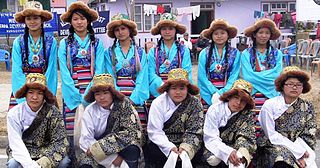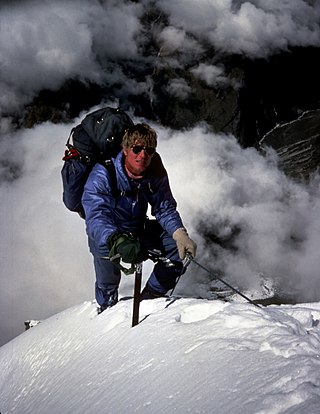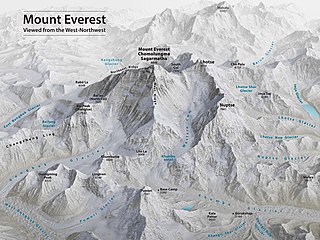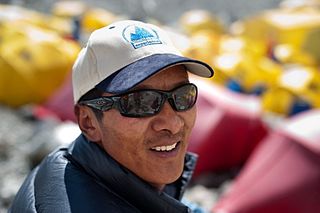Related Research Articles

K2, at 8,611 metres (28,251 ft) above sea level, is the second-highest mountain on Earth, after Mount Everest at 8,849 metres (29,032 ft). It lies in the Karakoram range, partially in the Gilgit-Baltistan region of Pakistan-administered Kashmir and partially in the China-administered Trans-Karakoram Tract in the Taxkorgan Tajik Autonomous County of Xinjiang.

Mount Everest is Earth's highest mountain above sea level, located in the Mahalangur Himal sub-range of the Himalayas. The China–Nepal border runs across its summit point. Its elevation of 8,848.86 m was most recently established in 2020 by the Chinese and Nepali authorities.

The Sherpa are one of the Tibetan ethnic groups native to the most mountainous regions of Nepal, Tingri County in the Tibet Autonomous Region and the Himalayas. The term sherpa or sherwa derives from the Tibetan-language words ཤར shar ('east') and པ pa ('people'), which refer to their geographical origin in eastern Tibet.

Dhaulagiri, located in Nepal, is the seventh highest mountain in the world at 8,167 metres (26,795 ft) above sea level, and the highest mountain within the borders of a single country. It was first climbed on 13 May 1960 by a Swiss-Austrian-Nepali expedition. Annapurna I is 34 km (21 mi) east of Dhaulagiri. The Kali Gandaki River flows between the two in the Kaligandaki Gorge, said to be the world's deepest. The town of Pokhara is south of the Annapurnas, an important regional center and the gateway for climbers and trekkers visiting both ranges as well as a tourist destination in its own right.

Scott Eugene Fischer was an American mountaineer and mountain guide. He was renowned for his ascents of the world's highest mountains made without the use of supplemental oxygen. Fischer and Wally Berg were the first Americans to summit Lhotse, the world's fourth highest peak. Fischer, Charley Mace, and Ed Viesturs summitted K2 without supplemental oxygen. Fischer first climbed Mount Everest in 1994 and later died during the 1996 blizzard on Everest while descending from the peak.

Junko Tabei was a Japanese mountaineer, author, and teacher. She was the first woman to reach the summit of Mount Everest and the first woman to ascend the Seven Summits, climbing the highest peak on every continent.

Robert Edwin Hall was a New Zealand mountaineer. He was the head guide of a 1996 Mount Everest expedition during which he, a fellow guide, and two clients died. A best-selling account of the expedition was given in Jon Krakauer's Into Thin Air, and the expedition has been dramatised in the 2015 film Everest. At the time of his death, Hall had just completed his fifth ascent to the summit of Everest, more at that time than any other non-Sherpa mountaineer.

Apa, nicknamed "Super Sherpa", is a Nepalese Sherpa mountaineer who, until 2017, jointly with Phurba Tashi held the record for reaching the summit of Mount Everest more times than any other climber. As part of The Eco Everest Expedition 2011, Apa made his 21st Mount Everest summit in May 2011 then retired after a promise to his wife to stop climbing after 21 ascents. He first summited Everest in 1990 and his last time to the summit was in 2011.

Mount Everest is the world's highest mountain, with a peak at 8,849 metres (29,031.7 ft) above sea level. It is situated in the Himalayan range of Solukhumbu district, Nepal.

The 1996 Mount Everest disaster occurred on 10–11 May 1996 when eight climbers caught in a blizzard died on Mount Everest while attempting to descend from the summit. Over the entire season, 12 people died trying to reach the summit, making it the deadliest season on Mount Everest at the time and the third deadliest after the 22 fatalities resulting from avalanches caused by the April 2015 Nepal earthquake and the 16 fatalities of the 2014 Mount Everest avalanche. The 1996 disaster received widespread publicity and raised questions about the commercialization of Everest.

Phurba Tashi Sherpa Mendewa is a Nepalese Sherpa mountaineer known for his numerous ascents of major Himalayan peaks. These include 21 ascents of Mount Everest, five on Cho Oyu, two on Manaslu, and one each on Shishapangma and Lhotse.
Lopsang Jangbu Sherpa was a Nepalese Sherpa mountaineering guide, climber and porter, best known for his work as the climbing Sirdar for Scott Fischer's Mountain Madness expedition to Everest in Spring 1996, when a freak storm led to the deaths of eight climbers from several expeditions, considered one of the worst disasters in the history of Everest mountaineering. Notwithstanding controversy over his actions during that expedition, Lopsang was well-regarded in the mountaineering community, having summited Everest four times. Lopsang was killed in an avalanche in September 1996, while again on an expedition to climb Everest for what would have been a fifth ascent.

On 5 April 1970, six Nepalese Sherpas died on Mount Everest. The deaths were caused by an ice-fall avalanche in the Khumbu Icefall. The icefall, which lies between Base Camp and Camp I, has been the site of numerous fatalities, including those in the 2014 Mount Everest ice avalanche. The Sherpas were assisting the Japanese Skiing Expedition, which included Yūichirō Miura, the first person to ski down Everest. Their names were Mima Norbu, Nima Dorje, Tshering Tarkey, Pasang, Kunga Norbu, and Kami Tshering. Another death occurred in the Japanese expedition four days later when Kyak Tsering was killed by ice falling from a serac.

On 18 April 2014, seracs on the western spur of Mount Everest failed, resulting in an ice avalanche that killed sixteen climbing Sherpas in the Khumbu Icefall. This was the same icefall where the 1970 Mount Everest disaster had taken place. Thirteen bodies were recovered within two days, while the remaining three were never recovered due to the great danger of performing such an expedition. Many Sherpas were angered by what they saw as the Nepalese government's meager offer of compensation to victims' families, and threatened a protest or strike. On 22 April, the Sherpas announced they would not work on Everest for the remainder of 2014 as a mark of respect for the victims.

Adventure Consultants, formerly Hall and Ball Adventure Consultants, is a New Zealand-based adventure company that brings trekking and climbing groups to various locations. Founded by Rob Hall and Gary Ball in 1991, it is known for its pioneering role in the commercialisation of Mount Everest and the 1996 Mount Everest climb during which eight people died, including Hall, a guide, and two Adventure Consultant clients.

Kami Rita, Thame, Solukhumbu District, Nepal is a Nepali Sherpa guide who, since May 2018, has held the record for most ascents to the summit of Mount Everest. Most recently, he scaled the mountain for a 28th time on 23 May 2023, breaking his own record set on 17 May 2023. His father was among the first professional Sherpa guides after Everest was opened to foreign mountaineers in 1950. His brother Lakpa Rita, also a guide, scaled Everest 17 times.
References
- ↑ "The West Ridge Direct". everesthistory.com. Retrieved 9 June 2011.
- ↑ "Everest - Fatilities". Archived from the original on 2011-06-13. Retrieved 2016-01-10.
